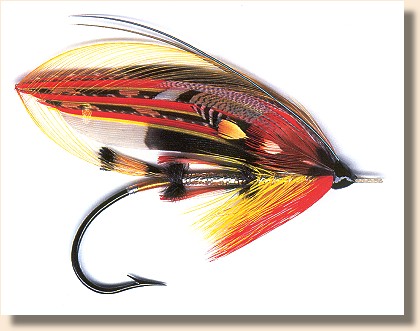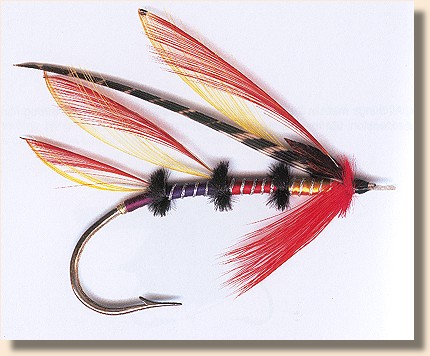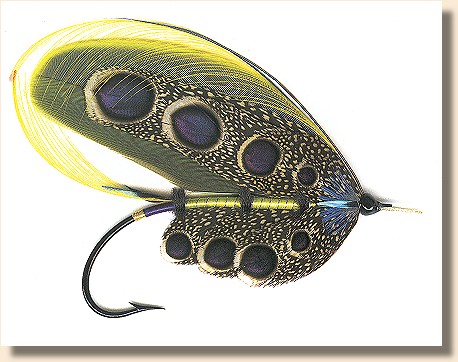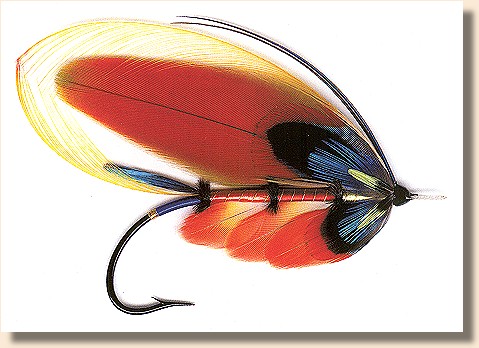Reviewed by Thomas C. Duncan, Sr.
 I was told about the book Century End by Paul Ptalis before
I ever touched a copy. A friend of mine who is a well-known salmon fly
tier saw it and emailed me saying it was a necessity that I take a look
at this new work. His enthusiasm was infectious, and when I got my
own copy I saw just why.
I was told about the book Century End by Paul Ptalis before
I ever touched a copy. A friend of mine who is a well-known salmon fly
tier saw it and emailed me saying it was a necessity that I take a look
at this new work. His enthusiasm was infectious, and when I got my
own copy I saw just why.
Century End, A Fly Tying Journey is not your typical book of fly
plates. This excursion into the world of the fully-dressed salmon fly deals
with both classic and innovative flies, a combination which might at first
seem incongruous. Ptalis' unique perspective on both makes them quite
correlative, though, and it provides for a pleasant read for anyone who
enjoys either genre.

The old classics are here: The Torrish, (shown above actual size from the book),
Popham, Green Highlander, and others
are present in their full glory. Authentic materials and antique hooks are assembled
in as beautiful a manner as you could hope. The proportions are perfect, the
lines are clean, the representations are accurate . . . what more could a reader ask?

How about some original patterns? They are here, too, and they are indeed unique.
The first fly in the book, in fact, (the "99 Pure" shown above), is unlike most other fully-dressed
flies I have ever seen. Many of Ptalis' own designs feature rare and exotic feathers
such as Tragopan Pheasant, Pitta, Minivet, Ibis, Trogon, Jendaya, and many other
feathers you aren't likely to find on the rack at your local shop. Ptalis also
implements less rare, but still interesting feathers from Parakeets, Loris, and
some under-tail coverts that are used to lovely and surprising effects.

Most of the featured original patterns are full feather-wing flies, reflecting the
recent explosion in popularity of this type of dressing. (For those unfamiliar
with the term, a feather-wing fly uses an entire feather, or significant part thereof, as the wing element of the fly. These feathers are generally quills or of structures similar to a quill.) These are the sweetest of eye-candy for the fan of exotic birds, employing a wide spectrum of colours from the Macaw species as wild
as a discotheque, to the subtly church-appropriate Elliot's Pheasant, with eyed
Peacock Pheasant displaying both qualities in balance. The bodies of most of
these feather-wings are veiled with feathers equally as interesting as the wings.
One fly, The Emerald Peacock, (shown above) even incorporates no fewer than ten full feathers into the wing! (Five on each side.) For those of us who have a hard time shelling out the high cash amounts to purchase these gems, these
photographs present a fair enough substitute.
Mr. Ptalis also treats our eyes to some original married-wing patterns, and again
he presents them with a unique perspective, but to describe that perspective,
I'll have to go back to the classic flies for a moment. In most books in which
a tier displays a known pattern, the credits are given as, "Designed by ______,
Tied by ________." The tier of these classics, though, does not represent himself
in this manner, but instead calls attention to himself as an interpreter of the pattern. Thus, The Floodtide is credited, "Originated by Geo. M. Kelson,
Interpreted by Paul Ptalis." This makes one conscious that Ptalis has approached the flies with more of an artistic point of view than the more common historical or
piscatorial one. That is not to say that they are not accurate, because they
are. It is simply to say that the desire is to show them primarily as the artistic
displays that they are.

This plays into the new flies, and explains some of their unusual qualities.
There are colours here that are by no means standard in terms of Salmon
Fly tying. Lavender, tangerine, flame, and myriad shades of the typical colours
abound on Ptalis' pallete, and they are applied masterfully to his craft. All the
married-wing flies exhibit certain colour patterns which determine the tone
of the fly. Rather than simply putting a few quill slips of different colours on
the wing, he arranges the slips in a particular order to achieve the desired
effect. On two flies in particular, Eck's Engine and JK's Fault, (shown above)
the bottom slips on the wing are yellow, and they gradually make their way through
hues of yellows, pinks, oranges, and reds to a deep crimson top. Other
flies proffer the same system less gradually, but no less beautifully from
yellow to purple or orange to purple. The effect is impossible to describe,
and must be seen to be believed.
Others still in his married-wing series settle on basic primary colours and the
'roygbiv' spectrum. These are colour studies in the simplest of shades arranged
in an anything-but-simple montage.
Now, I am accustomed to looking at flies with a critical eye, but I will admit
to being at a loss as an art critic. I love flies, but I know my limitations. Having
said this, there are certain flies that I do not understand in terms of design and
concept. Fortunately, this has not taken away any enjoyment from my perusals.
One thing I do know about art is the intent to represent mood, and these flies
do that. From the energetic Scarlet Queen to the somber Moon and Stars, the
loud Evan's Fancy to the shy African Grey, the conservative Elliot's to the liberal
Sun Conour, the stark 99 Pure to the robust Shewey's Marabou Blue, contrasts
in design and emotion abound, each with a graceful touch that Ptalis calls "flow,"
that is the primary intent of his tying. (There is a significant amount of page
space given at the beginning of the book to the topic of designing and tying flies
with this system. These comments and explanations will be helpful to the new
tier of Salmon flies as well as being highly useful food for thought to the old pro.)

One particular fly that stands out to me as displaying a contrast in colours with
a unity of aesthetics is the aptly-named "Harmony,"
(shown above). A wide range of colours and materials
are all combined, and the finished result is one
consistent flow from tip to head.
 The book does not end with the flies, though. They simply take up pages
18-51! From page 52 on, there are descriptions and full-size images of hooks
that are made for the art of Salmon Fly tying. Some are antique, some are
modern reproductions and inventions. Rather than just being silhouettes,
these are photographic images of hooks which allow you to see the actual
form of the iron rather than just the shape of the elements. These final pages
are a good resource, and fun to boot.
The book does not end with the flies, though. They simply take up pages
18-51! From page 52 on, there are descriptions and full-size images of hooks
that are made for the art of Salmon Fly tying. Some are antique, some are
modern reproductions and inventions. Rather than just being silhouettes,
these are photographic images of hooks which allow you to see the actual
form of the iron rather than just the shape of the elements. These final pages
are a good resource, and fun to boot.
Summarily, this new book is simply stunning visually. The photography is
extremely high-quality, and is printed on heavy stock, high gloss paper.
Every page is its own display in a softbound gallery. The fly photos are
quite large as well, each one taking up nearly half of its 8 1/2 x 11 page!
Appropriately enough, this book found another fan in my house -- my
two-year-old son. After I showed it to him, (he didn't get to touch it,)
he regularly asked for the "big fly book," and oohed and aahed at the
pictures, commenting all the while, "Red! Blue! Green!" A pretty good
recommendation, I think.
This book is published by Frank Amato Publications, and
sells for $19.95 at the Amato
Website, or by calling 1-800-541-9498. Whether you tie flies, or
just like looking at them, this book is for you! ~ Thomas C. Duncan, Sr.
Century End, A Fly Tying Journey
80 pages, Full-color photographs
8 1/2" x 11"
Softbound, $19.95 U.S
ISBN 1-57188-218-9
Published by
Frank Amato Publications, Inc.
P.O. Box 82112
Portland, OR. 97282
Previous Reviews
|







 The book does not end with the flies, though. They simply take up pages
18-51! From page 52 on, there are descriptions and full-size images of hooks
that are made for the art of Salmon Fly tying. Some are antique, some are
modern reproductions and inventions. Rather than just being silhouettes,
these are photographic images of hooks which allow you to see the actual
form of the iron rather than just the shape of the elements. These final pages
are a good resource, and fun to boot.
The book does not end with the flies, though. They simply take up pages
18-51! From page 52 on, there are descriptions and full-size images of hooks
that are made for the art of Salmon Fly tying. Some are antique, some are
modern reproductions and inventions. Rather than just being silhouettes,
these are photographic images of hooks which allow you to see the actual
form of the iron rather than just the shape of the elements. These final pages
are a good resource, and fun to boot.